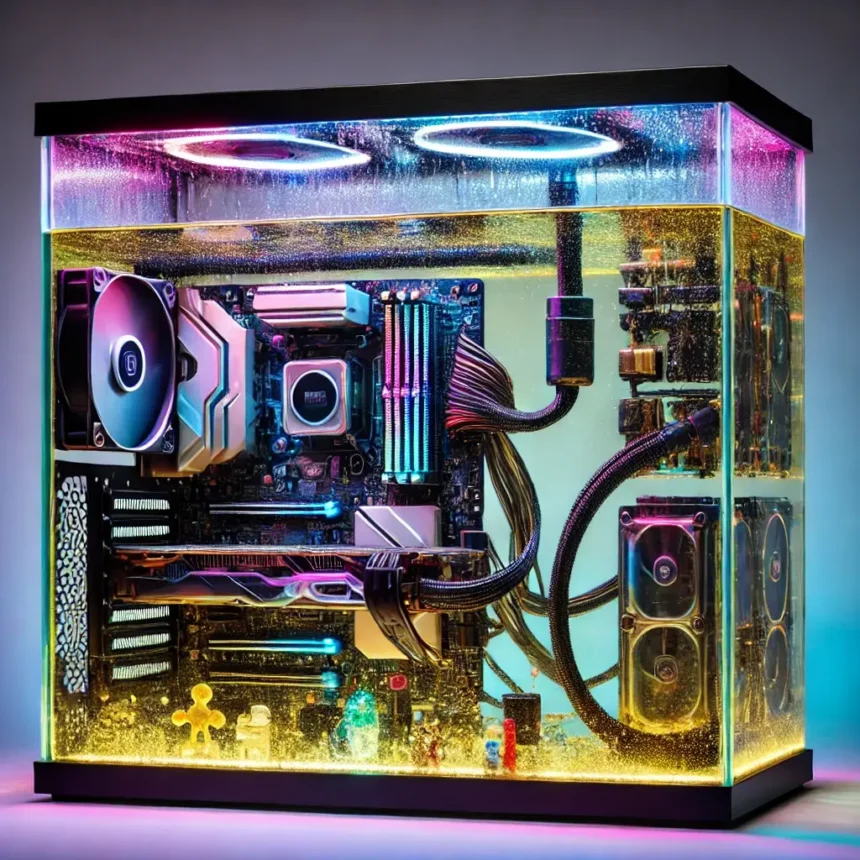Introduction
If you like to play with computers and take them apart, and if you want to put them back in place, you might be interested in creating a ‘tank Dell‘ system. Tank Dell is a term used to describe an unconventional method of computer building where the component’s arduous drives are immersed in mineral or cooking oil for cooling and noise reduction. This guide will help you safely and adequately put up your tank Dell system right in the comforts of your home.
Selecting Hardware Components
When selecting components to use in a tank Dell, there are a few key factors to consider:
- Ensure that all components are without fans or have fans that can be replaced. It will be impossible for the fans to operate effectively, especially when submerged in oil. Preferably, the GPUs and CPUs should be passively cooled.
- Do not choose products with exposed circuits or contacts on the circuit board. When traces or pins are exposed, the oil bath can cause problems.
- Old, used hardware is advised when one is beginning to practice tank Dell. Thus, you avoid high expenses if damage occurs.
- Specifically, SSD drives are used instead of HDD drives. SSDs are non-mechanical in design and best suited for submersion.
Assembling the Tank
You will require an aquarium, a terrarium, or any other transparent glass or plastic enclosure to house your oil-floated equipment. The tank size depends on the gear you want to submerge. It is essential to ensure that there are no backgrounds or decoys in the container that would hinder the immersion of the components.
A Few Tank Tips:
- Home stores, particularly those that sell food items and other household commodities such as plastic storage containers and acrylic aquariums, are ideal for tank Dell projects.
- When using an aquarium or a terrarium, dismantle any background or decoration inside it. Ensure the access holes are adequate in size to accommodate your components.
- The lid should be hinged or include a removable panel to help install hardware once oil is added.
Mineral Oil vs. Vegetable Oil
People are often deciding between light mineral oil and cooking-grade vegetable oil. Here is a quick comparison:
Mineral Oil:
- Light oil is employed for cosmetic purposes and as a mild laxative.
- Better quality, and it will not deteriorate over time.
- A bit messier if there is a leak.
Vegetable Oil:
- Available vegetable oil such as canola or peanut oil is commonly used in cooking.
- Less expensive but perishable after some time.
- Slower and less messy when there are small leaks.
Both types of oil are suitable for use in tank Dell systems. However, vegetable oil is preferable as an initial investment in tank Dell projects.
Preparing for Oil Immersion
Once you have your tank Dell hardware selected and the tank ready, follow these tips before pouring in the oil:
- Ensure that all hardware components are in good condition before submerging them. This means physically assembling the entire computer and installing and testing the motherboard, drives, and other equipment.
- Seal any part with a highly absorbent surface with paint, nail polish, or any other sealing agent to prevent the oil from being absorbed by the material used.
- Secure any wires, spares, screws, and other related items that may be required before fuelling the tank. The access becomes restricted once the oil is added.
Fueling and Refueling Your Tank Dell
When you’re ready for oil:
- Pour your tank’s oil slowly, giving the air being forced out a chance to exit. After filling it, a little space should be left at the top of the container.
- Start all the equipment briefly to see if there are any oil leaks or other problems. This will be done with the necessary adjustments before beginning the long-term operation.
- Check the status of oil and refill during service periods. Utilize foam blocks, cable ties, and acrylic rods to immobilize the components and reduce any shifting.
Creative Tank Dell Inspiration
Once familiar with the basics, consider getting creative with your tank Dell builds:
- Demonstrate RGB lighting effects using color-cycling LED strips and transparent case panels. The oil mediums spread RGB lighting in a fantastic way as it refracts.
- Plastic toy figurines, glitter shapes, or other acrylic objects can be suspended in the oil to enhance the appearance of the tank Dell.
- Add food coloring to the oil for a colored fluid effect. Layer different colors by combining vegetable oils dyed with other colors.
The options are virtually limitless when designing a fully custom tank Dell build.
FAQ – Tank Dell Questions Most Searched
What is a Tank Dell, and what are the benefits?
Tank Dells offer good thermal conductivity due to complete oil immersion cooling. They do not need fans and operate very quietly. Tank Dells also muffle noise from spinning hard drives and have aesthetic appeal.
What should I avoid when maintaining my Dell tank?
Check the coverage every six months to a year to ensure it has enough oil. Oil top-offs should also trigger a check for leakage and damage. Replace the oil completely after 2-3 years of use, as it may go rancid.
Can a mineral oil PC catch fire if there’s a short?
Mineral oil is not explosive and does not burn, melt, or undergo chemical change when exposed to fire. However, an internal electrical short may cause sparks or extreme heat, igniting neighboring hardware.
What hardware is optimal for a beginner Dell tank?
Inexperienced users should use old-generation hardware. A few generations’ old fanless CPU, used SSDs, and passively cooled graphics cards are perfect for a starter tank Dell system.
Conclusion
Building your tank Dell setup is a great project for PC hardware enthusiasts interested in oil immersion cooling. With proper precautions and suitable components, it can offer many years of silent, trouble-free service. Unleash your creativity with colored oils, floating objects, and custom lighting for a unique and functional build.




